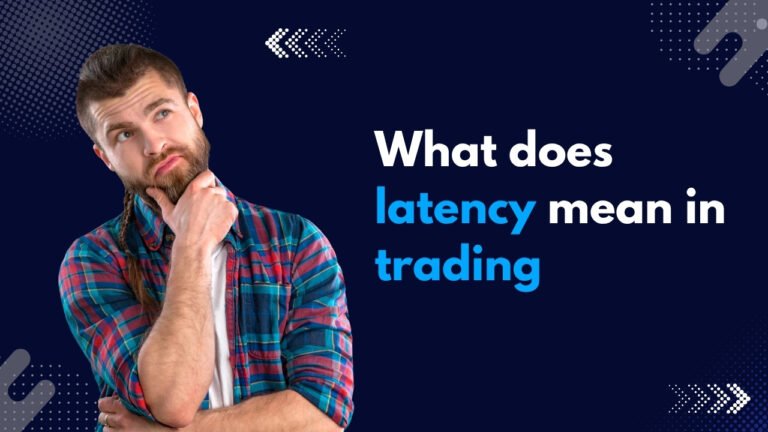Low Latency Trading: What Does Low Latency Mean
Low-latency trading aims to reduce the time between the order planned and executed to avoid trade delays. Learn how the approach can transform your trading.
Table of Contents
Time is money, and when your money is at stake, time becomes a far more crucial factor. In the trading world, every minute, prices change, and these changes can affect your trades.
The asset price even changes from the time you have analyzed the market and the time you have executed the trade. That’s the reason why traders have started switching to low-latency trading.
In this blog, we will study what low latency means in trading, the benefits, and tips for using the strategy. So let’s get started.
What Does Low Latency mean in Trading?
Low-latency trading is a strategy for trading financial assets such as forex, stocks, indices, cryptocurrencies, and others. The concept is simple; the strategy aims to reduce the time between the order planned and actually executed to avoid delays and improve overall trading results.
Low-latency trading strategy involves the usage of algorithms, high-frequency trading software, expert advisors, and advanced tools to reduce the delays even of micro or milliseconds.
Low-latency traders use advanced trade strategies. They can even take advantage of price discrepancies and changing market trends. Also the number of opportunities and probabilities of return are both higher.
Why Should You Go For a Low Latency Trade Strategy
Low-latency approach is beneficial for all, whether you are experienced or inexperienced, a risk-taker or conservative trader, you can take advantage of this approach. Let’s explore the benefits of the approach:
Best for High Frequency Trading Strategy:
Low-latency trading systems are especially beneficial for high-frequency traders. Such traders make multiple trades within fractions of a second. Now, suppose what would have happened if a mini-second trade had been delayed? It affects the overall results, right?
With microsecond trading systems, execution delays are minimized, allowing traders to take advantage of tiny price movements. The strategy ensures faster and timely order execution.
Preparation for Unpredictable Market Change:
Nobody can predict the market with 100% accuracy, but you can prepare yourself for unpredictable market changes. And you can do so with low-latency trading.
With a low-latency trading system, you can identify sudden market changes before others and even adjust the trading plans accordingly. As a result, your trading style becomes flexible to market change and even works during unfavourable times.
Better Risk Management:
The more you delay the trade, the more the risk increases. Your pace of placing the trade has a direct impact on your trading risk. In volatile environments, delayed executions can cause slippage or unfavourable fills.
Low-latency trading in forex or crypto ensures that stop-loss and take-profit orders are executed at the desired prices. It ensures that your gains and losses are both as per your expectations.
More Trade Opportunities and Returns:
A faster system not only protects against risk but also increases opportunities. When you analyze and execute within microseconds, identifying multiple market conditions becomes easy. Also, timely trade executions increase the chances of positive and higher trade returns.
Applicable in a Diverse Market:
One of the biggest advantages is that it works for different markets and trade styles. Whether you are trading forex, stocks, or crypto, low latency plays a crucial role.
Low-latency trading for crypto, forex ensures quick execution during volatile conditions. As in such markets, even a second of delay can cause major price differences. The strategy helps you handle fast-moving assets such as EUR/USD, XAU/USD, or BTC/USD.
Ideal for Arbitrage Trading:
Arbitrage trading is exploiting small price differences between two exchanges. Basically, traders buy from where the price is low and sell where the price is high.
The strategy is all about identifying and executing at a fast pace. Using a low-latency system has become a must for such traders.

Tips for Effective Low Latency Trading
Choose a Broker with Fast Execution:
Sometimes, even after timely analysis and execution, the trade gets delayed. And that’s because of the broker you are using. Thus, open an account with a high-frequency broker like Beirman Capital.
Optimize Hardware and Software Performance:
Use high-performance systems and network configurations for smooth operation. Most of the time, trade delays are caused by the lack of efficient resources.
Use Automated Trading Software:
Multiple Algorithms and robo software are available in the market. These can help traders in identifying, analyzing, and executing trades automatically, and help you in making your approach low-latency.
Have a Trading Blueprint:
When you have a blueprint of your trading journey, execution becomes simple. So, before entering the market, you should know what you will be doing.
Work on Your Speed:
Practice to increase your trading speed and improve analytical skills. However, practicing in a live market can cost you real money, so you can also use demo accounts and work on your speed.
Final Thoughts
Trading is all about timely identification of trade opportunities, early market analysis, and proper execution. Having a low-latency trading system enhances performance, minimizes risk, and increases overall trade returns.
Low latency helps you to stand out from the crowd, identify opportunities early, and be prepared for market conditions. The better the trading approach, the more the profit. Open a demo account with us and practice to eliminate trade delays.
FAQs
Low-latency trading is a strategy that aims to reduce the time between the order planned and actually executed to avoid delays and improve overall trading results.
Low Latency is important for timely and multiple trade execution, dealing with unpredictable market changes, efficient risk management, and higher returns.
Latency can be caused by slow internet connections, inefficient trading brokers, a lack of trading plans, and not using automated tools.
Beirman Capital offers low-latency trading networks with advanced trading tools and modern technologies.
Use faster internet, optimize your trading software, choose an efficient broker, and integrate automation to reduce trading latency.
Get Complete Forex Trading Assistance



